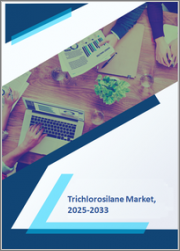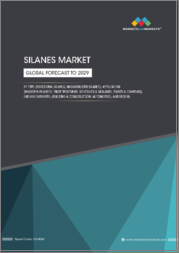
|
시장보고서
상품코드
1560958
실란 시장 보고서 : 제품, 용도, 최종 용도 산업, 지역별(2024-2032년)Silane Market Report by Product, Application, End Use Industry, and Region 2024-2032 |
||||||
세계의 실란 시장 시장 규모는 2023년에 19억 달러에 달했습니다. 향후 IMARC Group은 시장이 2032년까지 29억 달러에 달하며, 2024-2032년 4.2%의 성장률(CAGR)을 보일 것으로 예측하고 있습니다.
실란(H4Si)은 무색의 가연성 독성 가스로 강한 반발 냄새가 납니다. 규화 알루미늄과 염산 또는 암모늄, 나트륨, 망간, 염화제일철의 수용액으로 제조됩니다. 산화제와 반응하여 피부, 눈, 점막을 강하게 자극합니다. 접착 촉진제, 가교제, 커플 링제, 수분 포집제, 표면 개질제, 수지 첨가제 등 많은 산업 분야에서 널리 사용되고 있습니다. 또한 모세관 현상으로 인한 수분 흡수와 유해물질 발생을 억제하고 내동해성을 향상시켜 수성 액체 및 겔로도 사용됩니다.
세계동향 :
급격한 도시화는 가전제품에 대한 수요 증가와 함께 시장에 긍정적인 영향을 미치는 주요 요인 중 하나입니다. 이는 실란이 반도체 제조 및 전자 제품의 저전압 케이블 절연에 널리 사용되기 때문입니다. 또한 유리, 금속, 종이, 플라스틱, 석영, 엘라스토머 등의 기판에도 적용되고 있습니다. 이와 함께 스마트 가전제품 증가와 스마트홈의 출현은 시장에 밝은 전망을 가져다주고 있습니다. 이 외에도 태양전지 제조에 사용되는 비정질 실리콘 필름을 성장시키기 위해 다른 가스와 함께 사용됩니다. 또한 각국 정부는 개인의 태양광발전을 장려하기 위해 일부 태양전지판 부품에 대한 세금 공제, 혜택 및 가격 할인을 제공합니다. 이는 제조업체에 유리한 성장 기회를 제공합니다. 또한 실란의 가교 공정 및 특성 개선으로 인해 바닥 난방용 온수 파이프 및 발포체 제조에 대한 용도가 확대되고 있는 것도 시장 성장을 가속하고 있습니다.
이 보고서에서 다룬 주요 질문
- 2023년 세계 실란 시장 규모는?
- 2024-2032년 실란 시장 세계 시장 성장률은?
- COVID-19가 세계 실란 시장에 미치는 영향은?
- 세계 실란 시장을 촉진하는 주요 요인은?
- 세계 실란 시장 제품별 분류는?
- 세계 실란 시장 용도별 분류는?
- 세계 실란 시장의 최종 용도별 산업별 분류는?
- 세계 실란 시장의 주요 지역은?
- 세계 실란 시장의 주요 기업은?
목차
제1장 서문
제2장 조사 범위와 조사 방법
- 조사의 목적
- 이해관계자
- 데이터 소스
- 1차 정보
- 2차 정보
- 시장 추정
- 보텀업 어프로치
- 톱다운 어프로치
- 조사 방법
제3장 개요
제4장 서론
- 개요
- 주요 업계 동향
제5장 세계의 실란 시장
- 시장 개요
- 시장 실적
- COVID-19의 영향
- 시장 예측
제6장 시장 내역 : 제품별
- 알킬 실란
- 시장 동향
- 시장 예측
- 황 실란
- 시장 동향
- 시장 예측
- 아미노 실란
- 시장 동향
- 시장 예측
- 비닐 실란
- 시장 동향
- 시장 예측
- 에폭시 실란
- 시장 동향
- 시장 예측
- 메타크릴레이트 실란
- 시장 동향
- 시장 예측
- 모노/클로로 실란
- 시장 동향
- 시장 예측
- 기타
- 시장 동향
- 시장 예측
제7장 시장 내역 : 용도별
- 커플링제
- 시장 동향
- 시장 예측
- 접착 촉진제
- 시장 동향
- 시장 예측
- 소수화제 및 분산제
- 시장 동향
- 시장 예측
- 수분 제거제
- 시장 동향
- 시장 예측
- 규산염 안정제
- 시장 동향
- 시장 예측
- 기타
- 시장 동향
- 시장 예측
제8장 시장 내역 : 최종 용도 산업별
- 페인트 및 코팅
- 시장 동향
- 시장 예측
- 일렉트로닉스 및 반도체
- 시장 동향
- 시장 예측
- 고무와 플라스틱
- 시장 동향
- 시장 예측
- 접착제와 실란트
- 시장 동향
- 시장 예측
- 기타
- 시장 동향
- 시장 예측
제9장 시장 내역 : 지역별
- 북미
- 미국
- 캐나다
- 아시아태평양
- 중국
- 일본
- 인도
- 한국
- 호주
- 인도네시아
- 기타
- 유럽
- 독일
- 프랑스
- 영국
- 이탈리아
- 스페인
- 러시아
- 기타
- 라틴아메리카
- 브라질
- 멕시코
- 기타
- 중동 및 아프리카
- 시장 동향
- 시장 내역 : 국가별
- 시장 예측
제10장 SWOT 분석
- 개요
- 강점
- 약점
- 기회
- 위협
제11장 밸류체인 분석
제12장 Porter's Five Forces 분석
- 개요
- 바이어의 교섭력
- 공급 기업의 교섭력
- 경쟁의 정도
- 신규 진출업체의 위협
- 대체품의 위협
제13장 가격 분석
제14장 경쟁 구도
- 시장 구조
- 주요 기업
- 주요 기업의 개요
- Air Products Inc.
- Dow Inc.
- Evonik Industries AG
- Gelest Inc.(Mitsubishi Chemical Holdings Corporation)
- Momentive Performance Materials Inc.
- Nanjing Shuguang Chemical Group Co. Ltd.
- Power Chemical Corporation
- Rheinmetall AG
- Shin-Etsu Chemical Co. Ltd.
- Silar
- Tokyo Chemical Industry Co. Ltd.
- Wacker Chemie AG
The global silane market size reached US$ 1.9 Billion in 2023. Looking forward, IMARC Group expects the market to reach US$ 2.9 Billion by 2032, exhibiting a growth rate (CAGR) of 4.2% during 2024-2032.
Silane (H4Si) is a colorless, flammable, poisonous gas with a strong repulsive odor. It is prepared using aluminum silicide and hydrochloric acid or an aqueous solution of ammonium, sodium, manganese, and ferrous chloride. It reacts with oxidizing agents and is a strong irritant to skin, eyes, and mucous membranes. It is extensively used in numerous industrial applications, including adhesion promoters, crosslinkers, coupling agents, moisture scavengers, surface modifiers, and resin additives. Besides this, as it reduces capillary water absorption and harmful substances and improves frost resistance, silane finds application as a water-based liquid or gel.
Global Silane Market Trends:
Rapid urbanization, along with the escalating demand for consumer electronics, represents one of the key factors positively influencing the market. It can be attributed to the extensive applications of silane in the manufacturing of semiconductors and low-voltage cable insulation of electronic products. Additionally, it is applied to substrate materials, such as glass, metal, paper, plastic, quartz, and elastomer. Along with this, the rising trend of smart consumer electronics and the emergence of smart homes are creating a positive outlook for the market. Besides this, it is used along with other gases to grow amorphous silicon films that are employed in the manufacturing of solar cells. Furthermore, governments of various countries are offering tax credits, incentives, and price concessions on several solar panel components for encouraging individuals to use solar power. This, in turn, is offering lucrative growth opportunities to manufacturers. Moreover, expanding applications of silane in making under-the-floor hot-water heating pipes and foams on account of its improved crosslinking processes and properties are propelling the market growth.
Key Market Segmentation:
IMARC Group provides an analysis of the key trends in each sub-segment of the global silane market report, along with forecasts at the global, regional and country level from 2024-2032. Our report has categorized the market based on product, application and end use industry.
Breakup by Product:
- Alkyl Silane
- Sulfur Silane
- Amino Silane
- Vinyl Silane
- Epoxy Silane
- Methacrylate Silane
- Mono/Chloro Silane
- Others
Breakup by Application:
- Coupling Agents
- Adhesion Promoters
- Hydrophobing and Dispersing Agents
- Moisture Scavengers
- Silicate Stabilizers
- Others
Breakup by End Use Industry:
- Paints and Coatings
- Electronics and Semiconductors
- Rubber and Plastics
- Adhesives and Sealants
- Others
Breakup by Region:
- North America
- United States
- Canada
- Asia-Pacific
- China
- Japan
- India
- South Korea
- Australia
- Indonesia
- Others
- Europe
- Germany
- France
- United Kingdom
- Italy
- Spain
- Russia
- Others
- Latin America
- Brazil
- Mexico
- Others
- Middle East and Africa
Competitive Landscape:
The competitive landscape of the industry has also been examined along with the profiles of the key players being Air Products Inc., Dow Inc., Evonik Industries AG, Gelest Inc. (Mitsubishi Chemical Holdings Corporation), Momentive Performance Materials Inc., Nanjing Shuguang Chemical Group Co. Ltd., Power Chemical Corporation, Rheinmetall AG, Shin-Etsu Chemical Co. Ltd., Silar, Tokyo Chemical Industry Co. Ltd. and Wacker Chemie AG.
Key Questions Answered in This Report
- 1. What was the size of the global silane market in 2023?
- 2. What is the expected growth rate of the global silane market during 2024-2032?
- 3. What has been the impact of COVID-19 on the global silane market?
- 4. What are the key factors driving the global silane market?
- 5. What is the breakup of the global silane market based on the product?
- 6. What is the breakup of the global silane market based on the application?
- 7. What is the breakup of the global silane market based on the end use industry?
- 8. What are the key regions in the global silane market?
- 9. Who are the key players/companies in the global silane market?
Table of Contents
1 Preface
2 Scope and Methodology
- 2.1 Objectives of the Study
- 2.2 Stakeholders
- 2.3 Data Sources
- 2.3.1 Primary Sources
- 2.3.2 Secondary Sources
- 2.4 Market Estimation
- 2.4.1 Bottom-Up Approach
- 2.4.2 Top-Down Approach
- 2.5 Forecasting Methodology
3 Executive Summary
4 Introduction
- 4.1 Overview
- 4.2 Key Industry Trends
5 Global Silane Market
- 5.1 Market Overview
- 5.2 Market Performance
- 5.3 Impact of COVID-19
- 5.4 Market Forecast
6 Market Breakup by Product
- 6.1 Alkyl Silane
- 6.1.1 Market Trends
- 6.1.2 Market Forecast
- 6.2 Sulfur Silane
- 6.2.1 Market Trends
- 6.2.2 Market Forecast
- 6.3 Amino Silane
- 6.3.1 Market Trends
- 6.3.2 Market Forecast
- 6.4 Vinyl Silane
- 6.4.1 Market Trends
- 6.4.2 Market Forecast
- 6.5 Epoxy Silane
- 6.5.1 Market Trends
- 6.5.2 Market Forecast
- 6.6 Methacrylate Silane
- 6.6.1 Market Trends
- 6.6.2 Market Forecast
- 6.7 Mono/Chloro Silane
- 6.7.1 Market Trends
- 6.7.2 Market Forecast
- 6.8 Others
- 6.8.1 Market Trends
- 6.8.2 Market Forecast
7 Market Breakup by Application
- 7.1 Coupling Agents
- 7.1.1 Market Trends
- 7.1.2 Market Forecast
- 7.2 Adhesion Promoters
- 7.2.1 Market Trends
- 7.2.2 Market Forecast
- 7.3 Hydrophobing and Dispersing Agents
- 7.3.1 Market Trends
- 7.3.2 Market Forecast
- 7.4 Moisture Scavengers
- 7.4.1 Market Trends
- 7.4.2 Market Forecast
- 7.5 Silicate Stabilizers
- 7.5.1 Market Trends
- 7.5.2 Market Forecast
- 7.6 Others
- 7.6.1 Market Trends
- 7.6.2 Market Forecast
8 Market Breakup by End Use Industry
- 8.1 Paints and Coatings
- 8.1.1 Market Trends
- 8.1.2 Market Forecast
- 8.2 Electronics and Semiconductors
- 8.2.1 Market Trends
- 8.2.2 Market Forecast
- 8.3 Rubber and Plastics
- 8.3.1 Market Trends
- 8.3.2 Market Forecast
- 8.4 Adhesives and Sealants
- 8.4.1 Market Trends
- 8.4.2 Market Forecast
- 8.5 Others
- 8.5.1 Market Trends
- 8.5.2 Market Forecast
9 Market Breakup by Region
- 9.1 North America
- 9.1.1 United States
- 9.1.1.1 Market Trends
- 9.1.1.2 Market Forecast
- 9.1.2 Canada
- 9.1.2.1 Market Trends
- 9.1.2.2 Market Forecast
- 9.1.1 United States
- 9.2 Asia-Pacific
- 9.2.1 China
- 9.2.1.1 Market Trends
- 9.2.1.2 Market Forecast
- 9.2.2 Japan
- 9.2.2.1 Market Trends
- 9.2.2.2 Market Forecast
- 9.2.3 India
- 9.2.3.1 Market Trends
- 9.2.3.2 Market Forecast
- 9.2.4 South Korea
- 9.2.4.1 Market Trends
- 9.2.4.2 Market Forecast
- 9.2.5 Australia
- 9.2.5.1 Market Trends
- 9.2.5.2 Market Forecast
- 9.2.6 Indonesia
- 9.2.6.1 Market Trends
- 9.2.6.2 Market Forecast
- 9.2.7 Others
- 9.2.7.1 Market Trends
- 9.2.7.2 Market Forecast
- 9.2.1 China
- 9.3 Europe
- 9.3.1 Germany
- 9.3.1.1 Market Trends
- 9.3.1.2 Market Forecast
- 9.3.2 France
- 9.3.2.1 Market Trends
- 9.3.2.2 Market Forecast
- 9.3.3 United Kingdom
- 9.3.3.1 Market Trends
- 9.3.3.2 Market Forecast
- 9.3.4 Italy
- 9.3.4.1 Market Trends
- 9.3.4.2 Market Forecast
- 9.3.5 Spain
- 9.3.5.1 Market Trends
- 9.3.5.2 Market Forecast
- 9.3.6 Russia
- 9.3.6.1 Market Trends
- 9.3.6.2 Market Forecast
- 9.3.7 Others
- 9.3.7.1 Market Trends
- 9.3.7.2 Market Forecast
- 9.3.1 Germany
- 9.4 Latin America
- 9.4.1 Brazil
- 9.4.1.1 Market Trends
- 9.4.1.2 Market Forecast
- 9.4.2 Mexico
- 9.4.2.1 Market Trends
- 9.4.2.2 Market Forecast
- 9.4.3 Others
- 9.4.3.1 Market Trends
- 9.4.3.2 Market Forecast
- 9.4.1 Brazil
- 9.5 Middle East and Africa
- 9.5.1 Market Trends
- 9.5.2 Market Breakup by Country
- 9.5.3 Market Forecast
10 SWOT Analysis
- 10.1 Overview
- 10.2 Strengths
- 10.3 Weaknesses
- 10.4 Opportunities
- 10.5 Threats
11 Value Chain Analysis
12 Porters Five Forces Analysis
- 12.1 Overview
- 12.2 Bargaining Power of Buyers
- 12.3 Bargaining Power of Suppliers
- 12.4 Degree of Competition
- 12.5 Threat of New Entrants
- 12.6 Threat of Substitutes
13 Price Analysis
14 Competitive Landscape
- 14.1 Market Structure
- 14.2 Key Players
- 14.3 Profiles of Key Players
- 14.3.1 Air Products Inc.
- 14.3.1.1 Company Overview
- 14.3.1.2 Product Portfolio
- 14.3.1.3 Financials
- 14.3.1.4 SWOT Analysis
- 14.3.2 Dow Inc.
- 14.3.2.1 Company Overview
- 14.3.2.2 Product Portfolio
- 14.3.2.3 Financials
- 14.3.2.4 SWOT Analysis
- 14.3.3 Evonik Industries AG
- 14.3.3.1 Company Overview
- 14.3.3.2 Product Portfolio
- 14.3.3.3 Financials
- 14.3.3.4 SWOT Analysis
- 14.3.4 Gelest Inc. (Mitsubishi Chemical Holdings Corporation)
- 14.3.4.1 Company Overview
- 14.3.4.2 Product Portfolio
- 14.3.5 Momentive Performance Materials Inc.
- 14.3.5.1 Company Overview
- 14.3.5.2 Product Portfolio
- 14.3.6 Nanjing Shuguang Chemical Group Co. Ltd.
- 14.3.6.1 Company Overview
- 14.3.6.2 Product Portfolio
- 14.3.7 Power Chemical Corporation
- 14.3.7.1 Company Overview
- 14.3.7.2 Product Portfolio
- 14.3.8 Rheinmetall AG
- 14.3.8.1 Company Overview
- 14.3.8.2 Product Portfolio
- 14.3.8.3 Financials
- 14.3.9 Shin-Etsu Chemical Co. Ltd.
- 14.3.9.1 Company Overview
- 14.3.9.2 Product Portfolio
- 14.3.9.3 Financials
- 14.3.9.4 SWOT Analysis
- 14.3.10 Silar
- 14.3.10.1 Company Overview
- 14.3.10.2 Product Portfolio
- 14.3.11 Tokyo Chemical Industry Co. Ltd.
- 14.3.11.1 Company Overview
- 14.3.11.2 Product Portfolio
- 14.3.12 Wacker Chemie AG
- 14.3.12.1 Company Overview
- 14.3.12.2 Product Portfolio
- 14.3.12.3 Financials
- 14.3.12.4 SWOT Analysis
- 14.3.1 Air Products Inc.



















